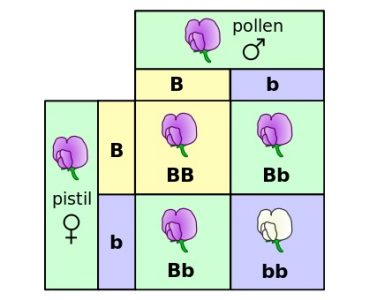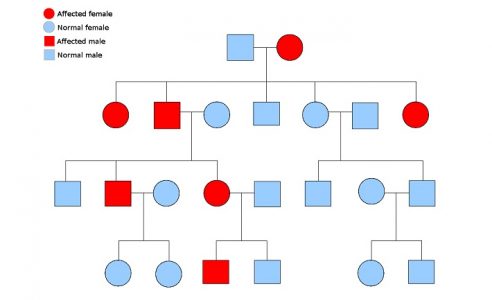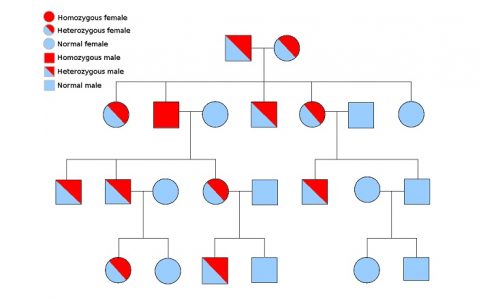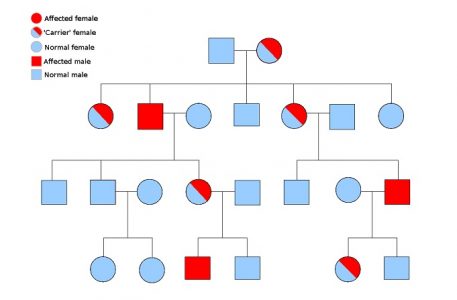Pedigree Definition
A pedigree is a diagram that depicts the biological relationships between an organism and its ancestors. It comes from the French “pied de grue” (“crane’s foot”) because the branches and lines of a pedigree resemble a thin crane’s leg with its branching toes. A pedigree is used for different animals, such as humans, dogs, and horses. Often, it is used to look at the transmission of genetic disorders.
Function of Pedigrees
The purpose of a pedigree is to have an easy-to-read chart that depicts a certain characteristic or disorder in an individual. It can be used for a characteristic like having a widow’s peak or attached earlobes, or a genetic disorder like colorblindness or Huntington’s disease. Besides being used to represent familial characteristics in humans, pedigrees are also important in animals that are selectively bred for certain characteristics. They visually represent the ancestors of an animal and make it easier to understand whether that animal will pass on certain characteristics to its offspring.
Pedigrees use a standard set of symbols to make them easier to understand. Males are represented by squares, while females are represented by circles. Parents are connected by horizontal lines, and vertical lines stemming from horizontal lines lead to the symbols for their offspring. The generations are also clearly marked with numbers, with I being the first generation, II being the children of the first generation, and III being the grandchildren, for example.
Dominant and Recessive Genes
To be able to understand pedigrees, one must understand dominant and recessive genes. Some characteristics, such as height, are influenced by a variety of genes and an individual’s environment. Height cannot be easily represented by a pedigree. Pedigrees are normally used to represent simple dominant and recessive traits. For example, having a widow’s peak hairline is dominant. If an individual has that trait, their symbol on the pedigree will be shaded in. If they have no widow’s peak, their symbol will not be shaded in because having no widow’s peak is recessive.
Certain traits like colorblindness are located on the X or Y chromosome and are called sex-linked. Colorblindness is more commonly found in males because males have only one X chromosome. Females are usually not colorblind because they have two X chromosomes and would need to inherit one defective X from both their mother and father. However, they can be carriers of the trait, and if they are carriers, their male children will be colorblind. On a pedigree, carriers are represented either by a half-shaded symbol or a shaded dot in the middle of the symbol.
Understanding Genes and Alleles
Why is it that two people with a dominant trait can sometimes have a child that shows the recessive trait? This can occur because people have two copies of each gene, one from their mother and one from their father. Different forms of a gene—such as widow’s peak or no widow’s peak—are called alleles. In genetics, the dominant allele is represented by a capital letter, like W, while the recessive allele is represented by a lowercase letter, like w. There are three different genotypes (genetic makeups):
- WW = dominant
- Ww = dominant
- ww = recessive
People with WW and Ww will have a widow’s peak, while ww individuals will have no widow’s peak. But if two people who have the Ww genotype reproduce, they could both pass on their w allele to the offspring, who will then be ww and will show the recessive trait.
WW and ww individuals are called homozygous because they have two copies of the same allele and will always pass that form of the allele on to offspring, while Ww individuals are called heterozygous because they have two different alleles and can pass on either allele to their offspring. In pedigrees, heterozygous individuals are represented by half-shaded symbols (just like carriers in pedigrees for sex-linked traits).

This diagram, called a Punnett square, shows the possible offspring of this heterozygotic pea plant, where purple is dominant (represented by B) and white is recessive (represented by b).
Examples of Pedigrees
Autosomal Dominant

This pedigree shows an autosomal dominant trait or disorder. Autosomal means the gene is on a chromosome that is not a sex chromosome (X or Y). Not all of the offspring inherited the trait because their parents were heterozygous and passed on two recessive genes to those that do not show the trait. None of the offspring of two recessive individuals have the trait. Examples of autosomal dominant disorders are Huntington’s disease and Marfan syndrome.
Autosomal Recessive

This pedigree is of an autosomal recessive trait or disorder. The completely red square represents a male that is homozygous recessive and has the trait. All of the half-shaded individuals are carriers; they do not exhibit the trait because it is recessive, but they could pass it on to their offspring if their partner is also a heterozygote. Autosomal recessive disorders include cystic fibrosis and Tay-Sachs disease.
Sex-Linked

This pedigree depicts a sex-linked disorder on the X chromosome. Some sex-linked disorders are dominant, and some are recessive; the pedigree above is of a sex-linked recessive disorder. In this pedigree, only males have the disorder, but some of the females are heterozygotic carriers who can pass down the trait even though they do not show it themselves. Colorblindness, hemophilia, and Duchenne muscular dystrophy are all sex-linked disorders.
Related Biology Terms
- Allele – a form of a gene. For example, in pea plants, B represents the dominant trait (purple color) and b represents the recessive trait (white color).
- Homozygote – an individual that has two of the same alleles for a gene, e.g., BB for a purple pea plant or bb for a white pea plant.
- Heterozygote – an individual with two different alleles, such as a pea plant that is Bb.
- Autosomal – relating to a chromosome that is not a sex chromosome.
Quiz
1. Which genotype represents a heterozygous individual?
A. AA
B. Aa
C. aa
D. A and C
2. An individual that shows a dominant trait could have one of what two genotypes for that trait?
A. AA or aa
B. Aa or aa
C. AA or Aa
3. What does a completely shaded-in symbol on a pedigree of an autosomal recessive trait represent?
A. An individual who shows the trait
B. An individual who does not show the trait
C. An individual who does not show the trait, but is a carrier
D. An unrelated individual
